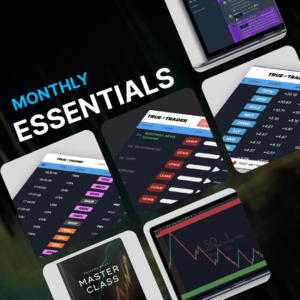Day trading is when an investor enters a long or short position and exits the position on the same day. This article explains 13 day trading tips that every beginner needs to apply to start day trading successfully.
As you start the day trading process, keep things simple. Learn all you can about a few important trading concepts, until you’ve mastered them. Once you’re confident about a particular concept, you can add some variations.
Start by selecting one market for day trading.
1. Select a Trading Market
Many day traders focus on trading common stocks. Publicly traded stocks can be traded each business day, and the markets offer liquidity. However, you may consider some other trading markets.
Trading Currencies
Forex.com explains the currency trade market: “Trading forex involves the buying of one currency and simultaneous selling of another. In forex, traders attempt to profit by buying and selling currencies by actively speculating on the direction currencies are likely to take in the future.”
Currency trading takes place 24 hours a day, 5 days a week, and the schedule impacts when you can place trades.
Investing in Futures
A futures contract allows you to trade a financial market on a specific date in the future.
Futures are a financial derivative, meaning that the future contract’s price is derived from the price of the underlying market. You can trade futures to speculate on a stock index, a commodity, or on interest rates. As an example, many investors speculate using S&P 500 stock index futures.
Using Stock Options
Stock options are also derivatives, and each option contract is based on the market price of an underlying stock. Investors pay a premium to purchase a call (right to buy stocks), or a put (right to sell stocks).
One option contract allows you to benefit from a stock price move on 100 shares of stock. This is a popular choice for those with less than $25,000 in their brokerage account.
2. Stay Informed About the Markets
Financial news and events impact trading markets, and day traders must stay informed to have current trading information. An increase in interest rates, for example, may be a positive for banks and some financial service companies.
You can scan reliable financial websites for news on individual stocks, trading tips, and announcements that impact the economy.
Day traders interested in keeping up with news that may impact a stock need the right tools to trade successfully.
3. Get the Right Equipment and Software
Your computer’s processor must allow you to run trading software without any lag time. Trading software can provide a number of charts and graphs, and you may want to use two monitors to quickly scan all of the data. You also need a fast and reliable internet connection to day trade.
There is a wide variety of firms that provide trading software that include financial data, charts, and graphs. At True Trader, we’ll provide you with the necessary platform recommendations and the best tools to be successful in day trading. Finally, you’ll need to select a broker to place trades on your behalf. Look for a firm that provides low commission rates, reliable execution on trades, and real-time streaming quotes.
Most day traders only trade for part of the day. You need to consider the market you’ve selected, and when you will trade.
4. Decide When to Trade
Day traders benefit when markets are volatile, because large price moves can generate more trading profits. Many traders focus on the first few hours that the markets are open, or trade during the last few hours before the close. These periods typically offer more volatility.
For example, if you trade Forex, the market trades 24 hours a day. As a result, you need to consider the types of currency that you want to trade, and when those markets see the most volatility. If you want to trade Euros, for example, you may find that trading is most volatile when both the London and New York markets are open.
Trading stocks, on the other hand, means you’ll be operating during intraday hours (on US-exchanges) between 9:30 a.m Eastern through 4:00 p.m. Eastern.
Day trading requires you to uncover profits in the markets, and to manage risk.
5. Learn to Manage Trading Risk
How much are you willing to risk in a single day?
To trade successfully, you need to set loss limits on your trades. You might limit the potential loss on a single trade to 1% of your capital, and your daily loss limit might be 3%. When you reach 3% in losses in a single day, you stop trading for the day.
This sort of self-discipline prevents you from larger losses that could wipe out your capital balance. If you’re able to generate more winning days than losing days, you can gradually build up your account.
6. Use Stop and Limit Orders
Consider using stop and limit orders, rather than market orders.
If a security is heavily traded and the market is volatile, the execution price you receive for a market order may change within seconds. Market orders are executed immediately, but the trader does not control the price.
Use stop and limit orders to indicate a specific price. These trades guarantee the price received, but not the time of order execution. A stop loss order, for example, can limit a trading loss, based on when the stock reaches a specific price.
If you own IBM common stock and want to sell when the price reaches $25, you can place a stop loss order. The order is triggered when the stock trades at $25 or lower, and becomes a market order that is executed immediately.
7. Trade a Small Number of Stocks
When you begin trading, focus on one or two stocks. Track those stocks during the trading session, and use your trading software to find profit opportunities.
Fractional shares allow traders to invest a specific dollar amount, and use those dollars to buy full and fractional shares of stock. This feature makes it easier to invest a particular dollar amount of capital.
Trading software allows you to practice trading before you put dollars into the market.
8. Practice Trading Strategies
Day trading requires you to use the same approach repeatedly, in order to focus and identify opportunities. Your trade plan should include these components:
- How to enter a trade
- How to set up stop loss order to limit the downside of the trade
- How and when to take profits
Most brokers offer a demo account in their trading software in order to test your strategy and learn from the results. Before you switch to live trading, practice using a demo account for several months.
Once you’re trading with money at risk, your emotions will play a role in your trading performance. If you practice and have confidence in your strategy (and you place limits on losses), you’ll have more success.
9. How Liquidity and Volatility Impact Trading
The liquidity and volatility of a stock have a big impact on the success of a particular trade.
If a stock has good liquidity, the market price you receive on a trade will be closer to bid and ask prices you see when the order is placed. This factor helps you set up trades that may be more profitable.
Assume, for example, that the IBM stock asking price is $42 and you’re looking to profit from a $1 per share price increase. The execution price for your market order should be close to $42, if the stock offers good liquidity.
Traders benefit from higher volatility, which means that the expected daily price range is high. If IBM’s volatility is expected to be between $39 and $45 per share, you have a better chance of earning a $1 profit on the $42 purchase price.
Higher trading volume indicates more investor interest in a stock, and more interest can result in higher volatility.
Level 2 quotes help you trade with more precision.
10. Consider Using Level 2 Quotes
You can subscribe to Level 2 quotes, which give you access to the NASDAQ order book in real time. NASDAQ (or over-the-counter) stocks are traded through market makers, which are institutions that offer a bid and ask for NASDAQ stocks. If you can see the order book, you have a more precise indication of the market in real time.
11. Profit Expectations
Don’t be frustrated if the dollar amount of your profits is small. If you follow a consistent trading system and generate more profitable trades than losses, you can benefit over time. Setting up trade limits and daily loss limits protect you from the downside, but also help you generate profits over the long term.
12. Keep Precise Records for Tax Filing Purposes
To file your taxes correctly, you need to know the buy and sell price on every trade. Your brokerage firm should provide statements that list this information, but you need to compile and calculate this information for your tax return. Filing your return will be complicated, and you should work with a tax accountant.
Regardless of which markets and platforms you choose, you need a trading system that provides useful research and results.
Taxes applied to short-term, day trading gains will reduce the take home return on your trades at the end of the year. You can offset gains with losses, but the tax rate on your gains will ultimately impact your total returns.
Tax laws on trading have changed in recent years, and you should work with a tax accountant to get a clear, personalized understanding of how your trades are taxed each year.
Use a Proven Trading System
True Trader teaches you how to trade stocks the right way. Our system focuses on high probability trading during the first hour of the day. We’ve invested over 25 years developing the True Trader Reversal Strategy and provide highly effective scanners to find the perfect setups for low-effort trading.


